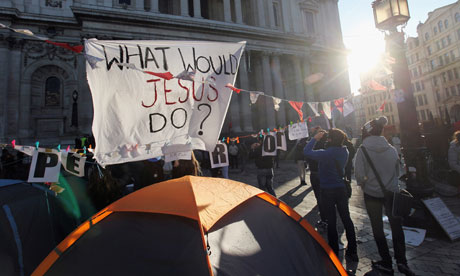
Photograph: Oli Scarff/Getty Images
Christian groups have drawn up plans to protect protesters by forming a ring of prayer around the camp outside St Paul's Cathedral, should an attempt be made to forcibly remove them.
As the storm of controversy over the handling of the Occupy LondonStock Exchange demonstration deepened on Saturday, Christian activists said it was their duty to stand up for peaceful protest in the absence of support from St Paul's. One Christian protester, Tanya Paton, said: "We represent peace, unity and love. A ring of prayer is a wonderful symbol."
With senior officials at St Paul's apparently intent on seeking an injunction to break up the protest, the director of the influential religious thinktank Ekklesia, Jonathan Bartley, said the cathedral's handling of the protest had been a "car crash" and predicted more high-profile resignations from the Church of England.
The canon chancellor of St Paul's, Dr Giles Fraser, and the Rev Fraser Dyer, who works as a chaplain at the cathedral, have already stepped down over the decision to pursue legal action to break up the camp.
Meanwhile, it has emerged that Shami Chakrabarti, director of the human rights group Liberty, is attempting to mediate in the dispute. She said she had contacted the corporation, cathedral and protesters to offer a "neutral space" to sort out the impasse. The corporation had not yet responded, she said, although St Paul's had acknowledged her offer. She said the protesters had been enthusiastic in their desire for dialogue and a peaceful resolution.
"It would have been easy to opt for a line of action that would have led to images of police dragging away protesters, but they want to talk."
It was claimed last night that a highly critical report into the moral standards of bankers has been suppressed by St Paul's amid fears it would inflame tensions over the protest. The report, based on a survey of 500 City workers who were asked if they thought they were worth their salaries and bonuses, was due to be published last Thursday.
But publication of the report, by the St Paul's Institute, has been delayed in apparent acknowledgement that it would give the impression the cathedral was on the side of protesters.
Christian groups that have publicly sided with the protesters include one of the oldest Christian charities, the Fellowship of Reconciliation, and the oldest national student organisation, the Student Christian Movement,Christianity Uncut, the Zacchaeus 2000 Trust and the Christian magazineThird Way. In addition, London Catholic Worker, the Society of Sacramental Socialists and Quaker groups have offered their support.
A statement by the groups said: "As Christians, we stand alongside people of all religions who are resisting economic injustice with active nonviolence. The global economic system perpetuates the wealth of the few at the expense of the many. It is based on idolatrous subservience to markets. We cannot worship both God and money."
Bartley said: "There are some very unhappy people within the Church of England. The protesters seem to articulate many of the issues that the church has paid lip-service to. Many people are disillusioned with the position St Paul's has adopted. To evict rather than offer sanctuary is contrary to what many people think the church is all about. The whole thing has been a car crash."
On Saturday afternoon, more than 20 religious figures gathered on the steps of St Paul's to support the occupation, which began two weeks ago.
The bishop of London, the Right Rev Richard Chartres, has promised to attend St Paul's in an attempt to persuade activists to leave. But protesters say they have no intention of packing up, many reiterating their intention to stay at the cathedral until Christmas and beyond.
A spokesman for Occupy London urged the City of London Corporation to open a dialogue with protesters to avoid a lengthy legal battle that could prove expensive for the taxpayer.















